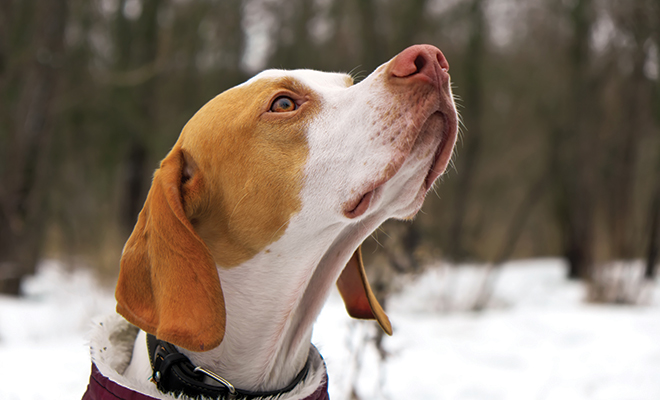
Saving the World by a Nose, Sniffer Dogs Now Have Many Jobs
When it comes to sniffing, dogs are in the animal top ten. Their noses have 300 million scent receptors compared to a human’s five million. Cats have only about 60 million receptors.
Dog’s brains are focused on evaluating odors, with an olfactory cortex 40 times that of humans. Some can detect a drop of fruit juice in the equivalent of 10 Olympic-sized swimming pools.
Today, this extraordinary canine talent is being used in brand-new ways to further help people. You’ll find sniffer dogs checking for explosives, working disasters and helping find and eliminate invasive species.
Bomb Sniffing Dogs
For the last 16 years, Auburn University’s College of Veterinary Medicine has conducted research to find the best dogs to sniff out explosives. The research includes MRI scans of dogs to discover how their noses work with their brains.
The school’s scientific breeding program produces canines built for the job, choosing to produce puppies not just for their superior sense of smell, but for trainability, high motivation, high energy, a long attention span and a willingness to work in any environment. In the end, of the 60 Labrador puppies born each year, only a few are selected for the more-than-year-long canine bomb detection grad school.
“These are dogs bred to be working dogs. They need a job or they’ll eat the molding off your car,” said the program’s director, L. Paul Waggoner. The program is so highly respected that the school can charge up to $50,000 for dogs (with handler training) to work at positions that include police departments, Major League Baseball, Disney World and Homeland Security.
Search and Rescue
Kathy Newman, a volunteer with the Minnesota Search and Rescue Dog Association, has a national reputation as a dog trainer and handler. Her dog Centa, a six-year-old Belgian Malinois, is part of a seven-member search-and-rescue team, all certified as Law Enforcement Training Specialists.
In the past, much of her work was finding lost people, but now, she says, that job is often assigned to drones. Currently, most of the team’s work is searching for cadavers. “You are going out for a body search so the families can have closure,” she said.
The dogs in her unit are trained by imprinting on the odors of human cadavers, using teeth, bones and placentas. “We want our dogs to search only for people and not be distracted by dead animals,” she said.
Newman travels to disaster sites around the country to offer her and Centa’s service and expertise, free of charge. Newman is on call 24/7. The team trains every Saturday, all year round, in all weather. They have been on searches when the wind chill dipped to -70º, but Newman loves her work. “I like to be outside and I like working with dogs. And, it’s a nice way to serve the community.”
Invasive Species
In New York, sniffer dogs are tracking down a noxious plant called scotch broom. Dogs are going after Chinese bush clover in Iowa, yellow star thistle in Colorado and pythons in the Everglades. Around the world, sniffer dogs are helping find and eliminate invasive species.
In Minnesota, the Department of Natural Resources uses dogs to find zebra mussels, an invasive species spreading through the state’s 10,000 lakes, destroying the habitat for native species of fish, shellfish and water plants. Conservation officer Julie Siems specializes in public waterways and wetlands, working with Brady, a rescued golden retriever mix. The DNR looks for floppy-eared dogs, reserving pointy-eared dogs for police apprehension work. “People want to talk with you when you’re with a floppy-eared dog,” she said.
When choosing the ideal candidate, she said, it’s hard to find the right dog. “There are a ton of dogs that are likable but not motivated. But I look for a dog with a lack of manners.” She knew that Brady had the right stuff on the first day of training. “We do a lot of the training inside DNR offices, using venison hides. He jumped up on a table and found the hide. Then, we got home and he jumped on the counter and ate a pizza.”
Now, Brady works sniffing bait buckets, portable docks and boats. Zebra mussels attach themselves to the bottom of watercraft; if not removed, they can spread to other lakes. Once a lake is infested, it’s impossible to eradicate them. When Brady finds attached mussels, Siems calls the decontamination unit. “If it’s something the owner couldn’t have seen, they get a citation. If the owner was just being lazy, it’s a misdemeanor, with a $500 fine.”
Cancer Sniffing
Dogs don’t yet work as diagnosticians, but new research is underway to see if dogs can accurately sniff out cancers in humans. If so, it will prove that in even more ways, dogs are man’s best friends. ■
Sources: wd4c.org, scienceabc.com, al.com, scientificamerican.com, americanveterinarian.com, www.vetmed.auburn.edu and dnr.state.mn.us.







